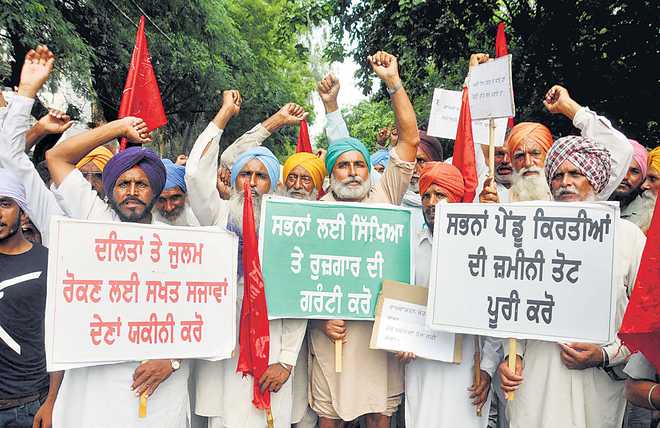Raja Sekhar Vundru
Dalit intellectual & bureaucrat
IN the run-up to the 1931 Census, the enumerators were confronted with new castes emerging from the untouchable communities. Suddenly, the untouchable castes, named Churas and Chamars, of Punjab when asked about their caste name, started mentioning that they were Ad-Dharmis, a movement started by Mangoo Ram, who had broken away from the Arya Samajis. It gave a new name to the untouchable castes, as their caste names were used in a derogatory and insulting manner.
In 1926, the untouchables of Punjab declared themselves a separate community and established the Ad-Dharm Mandal in Hoshiarpur district. The movement spread as a radical identity for the untouchable castes. In the 1931 Census, about 5 lakh untouchables declared themselves as Ad-Dharmis. In the UK, Doaba’s Ad-Dharmis are the single largest community of the Indian diaspora.
The non-Aryan theory, meaning thereby that Aryans have invaded and occupied India and initiated the caste system, took roots in the early 1900s. Untouchables themselves became a part of the Dravidian movement in the South and started calling themselves as Adi-Dravidians, Adi-Andhras and Adi-Karnatakas. Adi connotes the original sons-of-the-soil concept. Before this movement, the untouchables were also called Panchamas, meaning the fifth varna, after the Chaturvarna (of Brahman, Kshatriya, Vaishya and Shudra).
In 1917, a conference named the First Panchama Mahajana Sabha at Vijayawada renamed itself as the First Adi-Andhra Mahajana Sabha. The Adi-Andhra movement went full steam and by the 1931 Census, as many as 6,65,000 of the untouchable Mala (and some Madiga) castes of Andhra Pradesh had started calling themselves as Adi-Andhras. Bhagya Reddy Varma started the Adi-Hindu movement in the Nizam's Hyderabad (today's Telangana) after conferences started using the term in 1912 and established the Adi-Hindu Social Service League in 1924.
In 1922, the north India Chamar castes in the United Provinces (today's UP), led by Swami Achutanand, who moved out of Arya Samaj after questioning its oppressive scriptures, established the Adi-Hindu movement. At a conference in Allahabad in 1930, he declared that the Adi-Hindus were the descendants of the original inhabitants of India, who were the rulers and owners of the land of their birth, before the arrival of the Aryans into India.
The1935 Government of India Act for the first time listed all untouchable castes into a Schedule and they were officially called the Scheduled Castes. The Adi-Andhra, Adi-Dharmi, Adi-Dravida, Adi-Karnataka, hitherto unlisted castes, entered the list of Scheduled Castes. The Adi-Hindu term did not find mention in the list probably due to the sudden death of Swami Achutanand in 1933. After the Adi-Hindu movement faded away, the Chamars of UP termed themselves widely as Jatavs. The 1935 List of Scheduled Castes continued in the 1950 Constitution of India and all untouchable castes were officially called the Scheduled Castes.
The nomenclature of the untouchables changed in the early 20th century. The history of the untouchables’ etymology shows three stages. First was that of the scriptural names, calling untouchables as chandalas, shvapakas, antyajas and caste names emerged later as Panchamas, Mala, Madiga, Mahar, pariah, Chura and Chamar. Untouchables tried to escape the stigma attached to caste names which were dehumanising and degrading. The north Indian Chamars following the Bhakti saints called themselves Ravidasis, Kabirpanthis, scavenging castes called themselves Balmikis. But the escape from terminology was in vain and the oppression continued.
The second phase was when the Adi movements started. The untouchables jumped on to them. The Pariahs of Madras called themselves Adi-Dravidas and the rest of the South went on to add Adi prefixes. The Adi movement was the beginning of the assertion that the untouchable castes were the original inhabitants and that the upper caste oppressors were ‘outsider Aryans’.
The third phase started with the entry of Gandhi’s Harijan term. This was first used by Gandhi after his 1932 claim that untouchables were a part of Hinduism. He started a weekly journal by the name of Harijan and published it till his assassination. BR Ambedkar derided the term Harijan, meaning God’s children, as derogatory. The Ambedkarite movement eventually ensured the removal of the word Harijan to denote Scheduled Castes in official usage.
As the movement gained strength, the word Dalit (meaning ground down, oppressed) gained currency. It not only denoted oppression, but also became a radical identity of assertion against oppression. The movement flowered into the Dalit Panther movement (similar to the Black Panthers of the US) and Dalit Sahitya. Celebrated academics like Eleanor Zelliot published From Untouchable to Dalit in 1992 and Gail Omvedt in 1994 published Dalits and Democratic Revolution, establishing the term Dalit in the academia. Dalit literature now is a widely accepted genre of writing.
Eleanor emphasised that the use of ‘Dalit’ ‘was to indicate the idea that the untouchables of India have themselves chosen a new identity that of Dalit — to indicate their lack of belief in being polluting, their sense that their condition was the fault of caste system, and their inclusion in the Ambedkarite movement of all those subordinated by their religious, social and economic status’.
In their journey to seeking equality, Dalits have passed through several phases of struggle and etymology is the strongest of them. Starting in the 1970s, by the turn of the century, the word Dalit symbolised the most radical identity for the untouchables and spread, gaining deep roots into their consciousness. It seems that there is no turning back as the word Dalit has come to stay and is a part of the lingua franca of this nation and the world.
Unlock Exclusive Insights with The Tribune Premium
Take your experience further with Premium access.
Thought-provoking Opinions, Expert Analysis, In-depth Insights and other Member Only Benefits
Already a Member? Sign In Now











